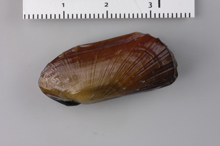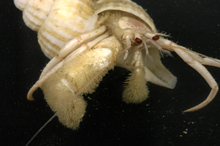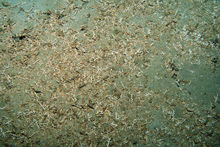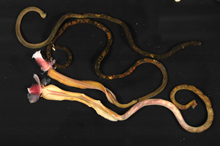
Researchers sampled these vestimentiferan worms (marine tube worms) from the cold seep called "The Builder's Pencil," during the New Zealand Seeps 06 (NEW ZEEPS 06) voyage on the research vessel (R/V) Tangaroa. Click image for larger view and image credit.
This bivalve mollusk (Acharax sp.) was also found at a cold seep site during NEW ZEEPS 06. Click image for larger view and image credit.
NEW ZEEPS 06
(New Zealand Seeps)
November 1 - 20, 2006
Dr. Amy Baco-Taylor
Woods Hole Oceanographic Institution
Dr. Ashley Rowden
National Institute of Water and Atmospheric Research, New Zealand
Dr. Lisa Levin
Scripps Institution of Oceanography
Dr. Craig Smith
University of Hawaii
There are at least four types of chemosynthetic ecosystems in the deep sea: hydrothermal vents, cold seeps, whale falls, and sunken wood. Chemosynthetic ecosystems are those in which the food chain is based primarily on microbial production from chemical energy, rather than a food chain derived directly from photosynthetic production from sunlight.
While many hydrothermal vent and cold-seep communities have been studied around the world, surprisingly little species overlap has been found among the different habitat types. This may be related to differences in substrate (a surface on which an organism grows or is attached) or chemistry, or it may reflect a sampling artifact (i.e., vents and seeps that occur in close proximity have rarely been sampled). It has also been hypothesized that whale falls and sunken wood may provide dispersal and evolutionary stepping-stones for vent and seep fauna. While some species-overlap has been found between whale fall/wood habitats and vent/seep habitats (because similar sampling artifacts exist), whale falls and sunken wood have not been studied in close proximity to vents or seeps.
The objective of New Zealand Seeps, or NEW ZEEPS 06, is to study the fauna and microbial communities of four types of chemosynthetic habitats in a place where we can remove distance as a factor for differences we see between habitat types. The waters around New Zealand are among the few places in the world where four chemosynthetic habitat types occur in close proximity. For this reason, we chose New Zealand as our study area. This is also why New Zealand has been chosen as a target area of the Census of Marine Life (CoML) Biogeography of Chemosynthetic Ecosystems program (see http://www.noc.soton.ac.uk/chess/ ![]() ).
).
Before we could make the broad comparisons between habitat types, we had to find the sites to study! So a primary goal on this cruise aboard the research vessel (R/V) Tangaroa was to pinpoint locations of cold seeps to sample on future cruises. Another goal was to implant wood-parcel experiments. Whale falls and sunken wood have frequently been brought up in fishing trawls around New Zealand, but we need exact positions to return to with a submersible or remotely operated vehicle (ROV). If we sink the wood ourselves, we know where to look! (We plan to sink a whale carcass and whale-bone packages in the next few months on a separate cruise.) Hydrothermal venting in New Zealand is now well known (see Ring of Fire 2005) with sites documented along the Tonga-Kermadec Arc, just north of New Zealand’s North Island.
The NEW ZEEPS 06 cruise was very successful. We discovered up to 15 seep sites during 3 weeks at sea. This represents the first in situ observation of cold-seep fauna in the southwest Pacific, with the nearest known cold-seep communities off Chile and Japan. One of our sites, “The Builder’s Pencil,” may be the largest seep site in the world, with characteristic seep fauna covering a continuous area of roughly 0.18 square km.
The majority of cold-seep sites were discovered or confirmed using a combination of multibeam mapping of sea-floor bathymetry (depth measurement) and single beam echosounders, which detect substrate structure and locate the bubble flares in the water column above the sites. Once potential seep sites were pinpointed, we lowered a towed video and still-camera system over each site to identify seep organisms and determine the areal coverage. This innovative imaging system fed video live to the ship, allowing us to observe the communities in real time as the R/V Tangaroa passed 1,000 m above. Ultimately, seep and background fauna were sampled using an epibenthic sled, grab, and multicorer.
This hermit crab was sampled from a cold seep site during the NEW ZEEPS 06 exploration. Note the seep-associated bacterial filaments (the furry-looking covering) on its claws. Click image for larger view and image credit.
There was some variation between the individual seeps, but all sites were distinguished from the surrounding deep-sea soft sediment communities by a plethora of the major types of life characteristic of chemosynthetic ecosystems. At the core of the seeps are biogenic carbonate (limestone) boulders and pavement-like slabs, with clumps of 30- to 40-cm long vestimentiferan tube worms emerging from fissures in the rock. Around the seep core are patches of blackened anoxic (without oxygen) sediment, pockets of white bacterial mats, extensive areas of dead and live shells belonging to three to four species of vesicomyid and other clams, bathymodiolin mussels, and a periphery of pogonophoran worms and deep-sea corals. Two of the sites also had abundant sponges, each with a different species. At one of the sites, black sulfidic sediments were recovered containing solid gas hydrate. (Gas hydrate is essentially a solid form of hydrocarbon gas, usually methane combined with other gases.) A variety of animal samples were collected, photographed, frozen, and preserved for systematic, biogeographic, genetic, biodiversity, and food-web research. Samples were also collected to study the chemistry and microbiology of the water and sediments.
The discovery of so many sites suggests that cold seeps are very abundant along New Zealand’s eastern continental margin. However, this expedition also revealed the extent to which these communities face serious anthropogenic (human caused) threats. At all of the seep sites, there was evidence of fishing damage in the form of trawl marks, lost fishing gear, and relatively large amounts of coral rubble compared to live coral. Any future mining of gas hydrates would likely also have a significant impact on the associated seep communities.
This expedition is the first step in a long-term program designed to characterize the fauna and microbial communities of deep-sea chemosynthetic habitat sites around New Zealand, including whale falls, sunken wood, hydrothermal vents, and cold seeps. As a prime location for our whale fall and wood studies, we also made an effort on this cruise to characterize the experimental area, Kaikoura Canyon. This canyon is a likely site for the occurrence of natural whale and wood falls and the accumulation of other biogenic debris. We found that the canyon floor has an extraordinary biomass of sediment “megafauna” (giant worms, burrowing sea cucumbers and urchins, enormous tube-building foraminifera) and is clearly an extremely productive habitat. The high productivity apparently results from the ability of the canyon to trap organic matter (terrestrial debris, kelp falls, wood and whale falls) from a large area. We hope to characterize the background canyon community for comparison to the wood and whale bone experiments we will implant in the canyon for later study.
Future research on New Zealand chemosynthetic ecosystems will require the use of submersible and/or remotely operated vehicle (ROV) technology to sample more precisely at implanted whale and wood experiments, as well as cold seep and hydrothermal vent habitats.
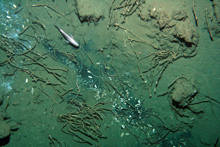
An orange roughy swims by vestimentiferan worms, Calyptogena (clam) shells, and carbonate (limestone) rocks at cold seep site photographed by the National Institute of Water and Atmospheric Research (NIWA) deep towed imaging system (DTIS) camera on the R/V Tangaroa. Click image for larger view and image credit.
Related Links
National Institute of Water and Atmospheric Research
"Bizarre deep-sea creatures imaged off New Zealand
," NewScientist.com, Nov 27, 2006.
"Creatures of the seeps discovered,
" Cosmos Online, Nov 24, 2006.
Sign up for the Ocean Explorer E-mail Update List.






